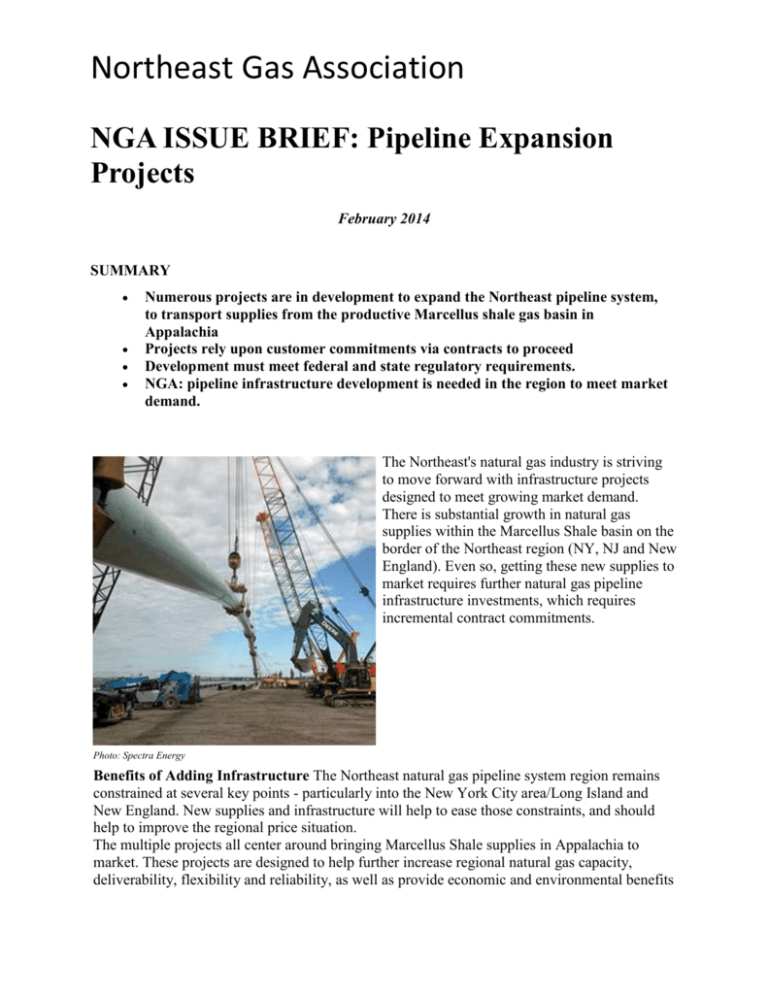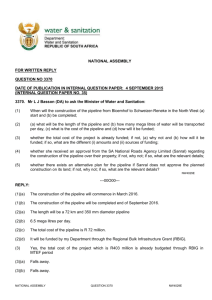
Northeast Gas Association
NGA ISSUE BRIEF: Pipeline Expansion
Projects
February 2014
SUMMARY
Numerous projects are in development to expand the Northeast pipeline system,
to transport supplies from the productive Marcellus shale gas basin in
Appalachia
Projects rely upon customer commitments via contracts to proceed
Development must meet federal and state regulatory requirements.
NGA: pipeline infrastructure development is needed in the region to meet market
demand.
The Northeast's natural gas industry is striving
to move forward with infrastructure projects
designed to meet growing market demand.
There is substantial growth in natural gas
supplies within the Marcellus Shale basin on the
border of the Northeast region (NY, NJ and New
England). Even so, getting these new supplies to
market requires further natural gas pipeline
infrastructure investments, which requires
incremental contract commitments.
Photo: Spectra Energy
Benefits of Adding Infrastructure The Northeast natural gas pipeline system region remains
constrained at several key points - particularly into the New York City area/Long Island and
New England. New supplies and infrastructure will help to ease those constraints, and should
help to improve the regional price situation.
The multiple projects all center around bringing Marcellus Shale supplies in Appalachia to
market. These projects are designed to help further increase regional natural gas capacity,
deliverability, flexibility and reliability, as well as provide economic and environmental benefits
Northeast Gas Association
to the region. They also are planned to bring natural gas liquids, such as ethane, to market, a byproduct of gas production.
In early November 2013, several pipeline additions in the New Jersey/New York City area did
go into service. As the U.S. EIA observed on November 14: "These expansions happened on
schedule, increasing access for consumers in the New York City metropolitan area to natural
gas produced in the Appalachian Basin's Marcellus Shale play. This has resulted in lower gas
prices for New York consumers, and has eased supply backup in the Marcellus Basin."
Additional infrastructure projects are planned to provide further needed access to Marcellus
supplies, not only for New York but also for New England, which remains perhaps the most
pipeline-constrained area in the U.S.
In addition, there are planned system expansions on local utility systems to meet growing
demand for natural gas - at the residential and commercial/industrial levels.
Importance of Contract Commitments to Project Advancement
The natural gas delivery system is designed to fulfill its contractual arrangements. Pipeline
capacity is added to meet the needs of gas customers requesting primary firm service and who
are willing to execute firm transportation contracts that pay for the required capital investment
and operating costs. Without such commitments and arrangements, projects cannot proceed.
The Federal Energy Regulatory Commission (FERC) in a December 2003 report on New
Northeast Gas Association
England's natural gas infrastructure noted:
"The adequacy of the natural gas infrastructure is based on its ability to fulfill its contractual
commitments. Natural gas may be contracted on a firm or interruptible basis. Interruptible
contracts are typically less expensive because capacity is only paid for if used, and the supplier
or transporter may interrupt service. The natural gas infrastructure is considered adequate if firm
commitments are met and terms of the interruptible contract are satisfied."
The Interstate Natural Gas Association of America (INGAA) noted in fall 2011 that "between
2005 and 2010, pipeline expenditures [in the U.S.] averaged $8.8 billion per year in real 2010
dollars."
However, natural gas pipeline companies do not design or build pipeline projects based on the
assumption that there will be a future market for transportation. Capital investment by pipelines
must be supported by revenue certainty through firm service agreements.
The U.S. Energy Information Administration (EIA) summarizes the various options for creating
additional pipeline capacity as including:
Building an entirely new pipeline
Adding a parallel pipeline along a segment of pipeline, called looping
Installing a lateral or extension off the existing mainline
Upgrading and expanding facilities, such as compressor stations, along an existing route.
What are the Stages of Pipeline Project Development? There are several stages of project
development. The following is adapted from a U.S. EIA paper.
Phase I:
Market
Assessment
and "Open
Season"
Market need and
project viability
assessed
Meet with
stakeholders
Project proposal
announced
"Open season" As shown in the chart above, pipeline capacity additions in the Northeast have been rising in recent years. The
outlook for further growth in 2013 - shown in pale green - is especially robust.
held to gauge
level of market Source: U.S. Energy Information Administration, March 25, 2013
interest among
potential customers
non-binding commitment to sign-up for a portion of the capacity rights available on the project
Northeast Gas Association
If enough interest is shown, sponsors arrive at preliminary design.
Phase 2: Development of final project design and obtaining of firm financial commitments
from customers; meet with stakeholders
Phase 3: Filing with regulatory agencies - federal, state, etc.
Phase 4: Regulatory review and issuing of necessary certificates
Phase 5: Construction
Phase 6: Commissioning and testing
The process from initial
development to commissioning
can take from 3 to 5 years, and
sometimes even longer.
Regulatory Review
The Federal Energy Regulatory
Commission (FERC) is the lead
permitting agency for interstate
pipeline projects. FERC is an
independent agency that regulates
the interstate transmission of
natural gas, electricity and oil.
In addition, projects require
certain state (and sometimes
local) permits, particularly in
environmental matters.
The U.S. EIA observes: "A
Photo: Yankee Gas Services Company
FERC review of an interstate
pipeline project takes from 5-18
months, with an average time of 15 months. No data are available on the average time for
obtaining approval from an individual State agency. Usually, approval by the regulating
authority is conditional, but most often the conditions do not constitute a significant
impediment. The project sponsor must then either accept or reject the conditions or reapply with
an alternative plan."
Opportunities for the Region
The Marcellus supply production and the related infrastructure development offer great
opportunities to the economy and environment of the Northeast. This region remains one of the
most highly-populated, highly-priced and yet most highly-constrained gas markets in the U.S.
These supply and pipeline developments have the potential of transforming the traditional paths
of supply sourcing into the region, creating a more diverse supply mix and a more varied
delivery network. This bodes well for regional supply security and economic competitiveness.
For Further Information
NGA Summary of Proposed Northeast Pipeline Projects [pdf]
U.S. EIA Outline of Pipeline Development Process
U.S. FERC
Interstate Natural Gas Association of America (INGAA)
Northeast Gas Association
Copyright Northeast Gas Association © 2014. All Rights Reserved.
Northeast Gas Association
75 Second Avenue, Suite 510, Needham Heights, MA 02494-2859 | Phone 781.455.6800 |
Fax 781.455.6828
NYSEARCH/NGA
20 Waterview Boulevard, 4th Floor, Parsippany, NJ 07054 / Phone 973.265.1900 / Fax
973.263.0919






